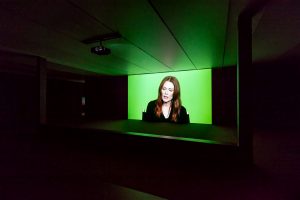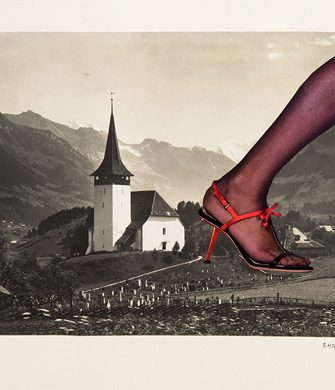Goodman Gallery, Johannesburg
03.02-10.03.2018
As one enters the Candice Breitz exhibition at the Johannesburg Goodman Gallery there are black curtains and there is a video on the wall centred in the room. You’re very aware of Alec Baldwin and Julianne Moore’s voices resonating through the space, and even though I knew ahead of time that I would hear their voices, it was surprising how recognizable his voice is, distinctly his, the warm timbre of his spoken words. I know that it’s him. This becomes important later.
The first video in the gallery is Profile, 2017. There are three variations on the video – A, B, and C – with ten South African artists alternately stating that they are Candice Breitz and relating aspects of ‘their’ identity. They are not speaking as themselves or about themselves, necessarily, although there are moments that one can attach the information to the artists. It becomes pertinent that Breitz is examining national identity, issues of home, place, self and the binaries attached to the expectations of a person from a specific geographic location. This multifaceted work explores what constitutes identity – gender, race, heritage, belonging, class, etc – all the things by which we define ourselves and others. Made for exhibition at the 57th Venice Biennale on the South African pavilion, Profile is a statement about the limitations of curating an exhibition representative of a national population – commenting on the variety of artists that could have been selected for exhibition, but were not, and questioning whether they would have been any different, really, in representing an idea as big as a nation.
Breitz lined up the works so that the audience engages with it in a very particular order. At first one is confronted with the intentional identity-based confusion of Profile, while hearing the voices of the actors in Love Story in the next room with whom one is confronted next. The screen is massive, and the green-screen backdrop is echoed in the green carpet running the length between the video and the viewer. One is inserted into the narrative through the carpet. This huge screening of the familiar faces of Alec Baldwin and Julianne Moore is overwhelming and alluring, captivating. One is confronted with the very materiality of their skin and their facial features, the expressions so clear and tactile. The last room is hidden in the dark, with the almost invisible entrances to it on either side of the massive screen. The final room contains six screens, twelve pairs of headphones and twelve stools to watch the videos from. This order, and the length of the videos means that, should you watch Profile, A, B and C, and the entirety of Love Story, you have already spent 82 minutes and 50 seconds at the exhibition.
Should you decide to stay and engage with the videos in the final room, if you even found it, you are exhausted, and you have to decide how long to spend with each of the refugees whose stories you have already heard in some curated detail. Each of their videos is around three hours long. This creates an impossible scenario, in some ways, where the viewer is forced to disregard the refugees themselves and engage almost exclusively with the ‘artist profile’ and the actors. The videos are online, however, if you wish to engage with them further. It’s an incredibly clever reuse that leaves you wondering whether you would have engaged with the refugees for any longer anyway if the order of presentation had been different. Being cramped and uncomfortable, the setup of the room itself seems to create discomfort. It seems that Breitz creates an intentional disconnect between the refugees and the viewer, to emphasize the actual disconnect viewers, and people, end up having with refugees.
The content of the videos themselves is another review entirely. It’s impossible to summarize the experiences and emotive responses of the refugees here but that their stories are very important for others to hear, and that their experiences encapsulate any human’s worst nightmare.
Breitz confirmed that the way visitors choose to spend their time in the space becomes a part of the work, and is ‘very much integral to how the work produces meaning.’ Breitz mentions ‘investment’, ‘currency’ and ‘economies’ in reference to the audience’s time spent on certain areas, which reveal many things about the individuals that participate by viewing. How people spend time in the space is revealing about priorities, interest, empathy and socialization. But in some ways, the curatorial process sets up the viewer to fail to interact with the refugees themselves for anything longer than a few minutes each, and this, in itself, is something that forces the viewer to examine all of these things about themselves, related to the currency certain areas of the exhibition have in opposition to others.
[calltoaction]











